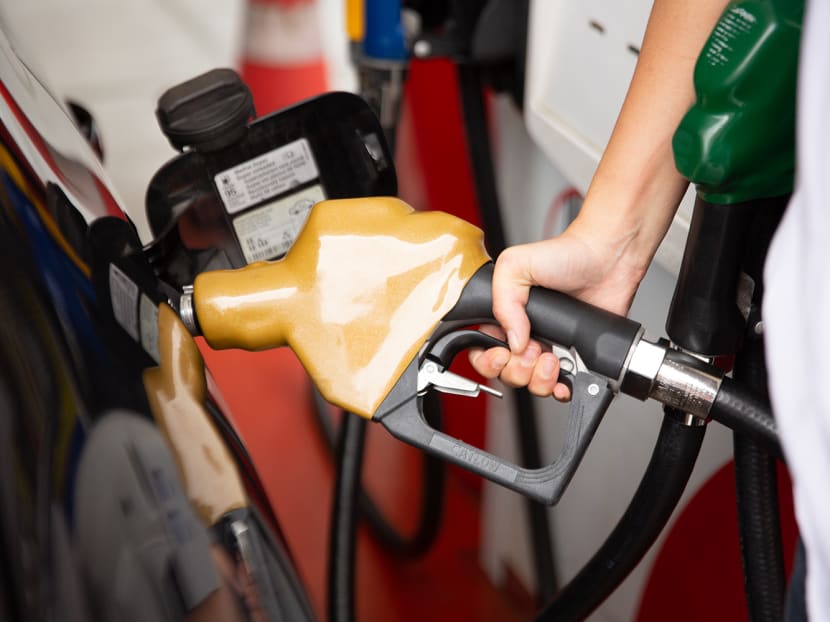Explainer: The factors behind rising oil prices and the impact on Singaporeans
SINGAPORE — The issue of high oil prices is set to be aired in Parliament on Monday (April 4), with 11 Members of Parliament having filed questions on measures the Government is taking to soften its impact.

- The issue of high oil prices is set to be aired in Parliament on Monday
- The price of petrol has dipped over the last week but remains above the S$3 per litre mark
- Russia’s war with Ukraine is widely attributed to be the cause of the surge in oil prices but experts believe global recovery from Covid-19 recession is the main factor
- Oil prices are biting into consumers' pockets and Singaporeans will feel the impact in their daily lives
SINGAPORE — The issue of high oil prices is set to be aired in Parliament on Monday (April 4), with 11 Members of Parliament having filed questions on measures the Government is taking to soften its impact.
Motorists in Singapore have been feeling the pinch as petrol prices remain at a record high. The price of petrol has dipped over the last week but is still above the S$3-per-litre mark.
Fuel Kaki, a pump price tracker by the Consumers Association of Singapore, listed the price of 95-octane petrol as ranging from S$3.00 to S$3.05 a litre.
Petrol prices are pegged to crude oil prices, which remain above US$100 (S$136) per barrel. This is even as Brent crude oil slipped from US$120 to US$104 per barrel over the last week.
Why are oil prices staying at record highs and what is the impact on consumers? TODAY speaks to experts to find out.
RUSSIA-UKRAINE WAR NOT UNDERLYING CAUSE
The surge in oil prices has been widely attributed to supply disruptions resulting from Russia’s war with Ukraine.
However, experts agree that it is not the underlying cause.
Rather, global recovery from Covid-19 is the main driver behind the hike in oil prices.
There are also supply bottlenecks from the underinvestment in oil production capabilities among members of the Organization of Petroleum Exporting Countries and its allies (Opec+).
This was after Covid-19 drove down oil prices and created less incentive for industry players to expand capabilities.
“Rising petrol prices move in tandem with crude oil prices. The latter are a reflection of the recovery in global growth and oil demand, exacerbated by Russia-Ukraine conflict and OPEC+'s reluctance and inability to ramp up their output in the near term,” Ms Selena Ling, head of treasury research and strategy at OCBC Bank, said.
Stronger demand from economies regaining momentum has driven oil prices up. This phenomenon was seen before — the last time oil prices hit US$100 per barrel was when economies rebounded after the Global Financial Crisis of 2008.
Mr Irvin Seah, executive director and senior economist at DBS, said: “Demand is normalising to 2013-2014 levels. After the Global Financial Crisis, there was a sharp rebound in growth in 2010. This drove oil prices significantly upwards to US$100 per barrel from 2011 to 2014. What we are seeing today mirrors the global recovery trajectory and its impact on oil demand.”
OIL PRICES BITING INTO SINGAPOREANS’ POCKETS
For every 10 per cent rise in oil prices, Singapore’s inflation rate will grow by 0.2 per cent, according to Japanese financial holding company Nomura Holdings.
Surges in oil prices will have a ripple effect throughout the economy.
“End-consumers will feel the pinch as it’s not only rising pump prices, but also price increases across a broad range of goods and services, such as food, transport prices, healthcare and education costs,” said Ms Ling.
CIMB economist Song Seng Wun added: “From the moment we wake up, the toothpaste we use, to switching on the lights and taking transport to work — our demand for these goods and services has remained but the prices have gone up.”
Consumers are paying more for transport as several private hire and taxi operators have recently announced temporary fare increases to cushion the rise in petrol prices.
Grab has increased its driver fee by S$0.50 per ride while ComfortDelGro's hikes mean that commuters pay an extra 32 cents for every 10km travelled.
Mr Seah projected that Singapore’s inflation will stay high at about 4 per cent before trending downwards at the end of the year. He noted that this is significantly higher than the historical average of around 2 per cent.
If wages do not keep pace with inflation, the purchasing power of the average Singaporean will diminish.
However, wages are likely to increase, said Ms Ling. “Given that the headline, resident and citizen unemployment rates have returned to pre-Covid levels, while the foreign manpower policy remains tight, it is likely to translate to increased wage pressures.”






